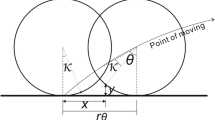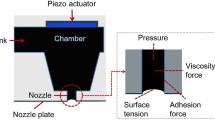Abstract
The velocity control of a roller is crucial in gravure offset printing for determining the quality of the printed images such as width and thickness of an electric circuit. The velocity control also affects mass printability, especially when using micro-scale liquid of high conductivity ink. In this work, a liquid transfer model for gravure offset printing is developed using the phase field method to investigate interfacial dynamics. As a numerical scheme, the finite element method is used for discretization of the partial differential equation. The interfacial layer governed by the phase field variable is embodied by the Cahn–Hilliard equation for a convection–diffusion problem. The numerical results are compared with those from the literatures for their validation. The results were found to be in good agreement with both analytical and experimental results in the literatures. After the validation, the effects of several key factors in gravure offset printing, such as velocity, gravity, surface tension and viscosity on liquid transfer are studied with respect to the contact angle of the upper plate. The ranges of the velocity and contact angle are varied from 0.01 to 0.25 m/s and from 30° to 70°, respectively. Also, the values of the surface tension and viscosity are changed from 0.5 to 1.5 N/m and from 0.05 to 0.15 N s/m2, respectively. The simulation result showed that at α = β = 60° regardless of gravity, the liquid transfer rate (R %) is increased as the velocity of the upper plate is increased at velocities below 0.01 m/s for liquid with low density, whereas the liquid transfer rate is decreased as the velocity is increased for liquid with high density. Also, the liquid transfer rate is increased as the surface tension is increased until the contact angle (α ≤ β = 60°) approached 60°. Whereas the liquid transfer rate is decreased as the surface tension is increased until the contact angle (α ≤ β = 60°) is increased to 60°.













Similar content being viewed by others
References
Ahmed DH, Sung HJ, Kim D (2011) Simulation of non-Newtonian ink transfer between two separating platesfor gravure-offset printing. Int J Heat Fluid Flow 32:298–307
Darhuber AA, Miller SM, Troian SM and Wagner S (2000) Process simulation for contact print microlithography. In: Technical proceedings of the international conference on modeling and simulation of microsystems, San Diego, Mar 2000, pp 28–31
Elsayad S, Morsy F, El-Sherbiny S, Abdou E (2002) Some factors affecting ink transfer in gravure printing. Pigm Resin Technol 31:234–240
Gillett EK et al (1991) Gravure process and technology. Gravure Association of America, Gravure Education Foundation
Hagberg J, Pudas M, Leppävuori S, Elsey K, Logan A (2001) Gravure offset printing development for fine line thick film circuits. Microelectron Int 18:32–35
Hahne P, Hirth E, Reis IE, Schwichtenberg K, Richtering W, Horn FM, Eggenweiler U (2001) Progress in thick-film pad printing technique for solar cells. Sol Energy Mater Sol Cells 65:399–407
Hu HH, Patankar NA, Zhu MY (2001) Direct numerical simulations of fluid–solid systems using the arbitrary Lagrangian-Euleriantechnique. J Comput Phys 169:427–462
Huang W, Ren Y, Russell RD (1994) Moving mesh methods based on moving mesh partial-differential equations. J Comput Phys 113:279–290
Huang W, Lee SH, Hyung JS, Lee TM, Kim DS (2008) Simulation of liquid transfer between separating walls for modeling micro-gravure-offset printing. Int J Heat Fluid Flow 29:1436–1446
Kang HW, Sung HJ, Lee TM, Kim DS, Kim CJ (2009) Liquid transfer experiment for micro-gravure-offset printing depending on the surface contact angle. J Micromech Microeng 19:15–25
Kim CH, Shin SH, Lee HG, Kim J (2009) Phase-field model for the Pinchoff of liquid–liquid jets. J Korean Phys Soc 55:1451–1460
Lee S, Na Y (2010) Analysis on the ink transfer mechanism in R2R application. J Mech Sci Technol 24:293–296
Mikami Y et al (1994) A new patterning process concept for large-area transistor circuit fabrication without using an optical mask aligner. IEEE Trans Electron Device 41(3):306–314
Milosevic IN, Longmire EK (2002) Pinch-off modes and satellite formation in liquid/liquid jet systems. Int J Multiph Flow 28:1853–1869
Powell CA, Savage MD, Guthrie JT (2002) Computational simulation of the printing of Newtonian liquid from a trapezoidal cavity. Int J Numer Meth Heat Fluid Flow 12:338–355
Pudas M, Hagberg J, Leppavuori S (2002) The absorption ink transfer mechanism of gravure offset printing for electronic circuitry. IEEE Trans Electron Packag Manuf 25:335–343
Pudas M, Hagberg J, Leppävuori S, Elsey K, Logan A (2004a) Methods for the evaluation of fine-line offset gravure printing inks for ceramics. Color Technol 120:119–126
Pudas M, Hagberg J, Leppavuori S (2004b) Printing parameters and ink components affecting ultra-fine-line gravure-offset printing for electronics applications. J Eur Ceram Soc 24:2943–2950
Sethian JA, Smereka P (2003) Level set methods for fluid interfaces. Ann Rev Fluid Mech 35:341–372
Yue P, Feng JJ, Liu C, Shen J (2004) A diffuse-interface method for simulating two-phase flows of complex fluids. J Fluid Mech 515:293–317
Yue P, Zhou C, Feng JJ, Ollivier-Gooch CF, Hu HH (2006) Phase-field simulations of interfacial dynamics in viscoelastic fluids using finite elements with adaptive meshing. J Comput Phys 219:47–67
Acknowledgments
This research was supported by the Yeungnam University Research Grants in 2009.
Author information
Authors and Affiliations
Corresponding author
Rights and permissions
About this article
Cite this article
Park, SS., Jeon, Y., Cho, M. et al. The FEM based liquid transfer model in gravure offset printing using phase field method. Microsyst Technol 18, 2027–2034 (2012). https://doi.org/10.1007/s00542-012-1652-4
Received:
Accepted:
Published:
Issue Date:
DOI: https://doi.org/10.1007/s00542-012-1652-4




